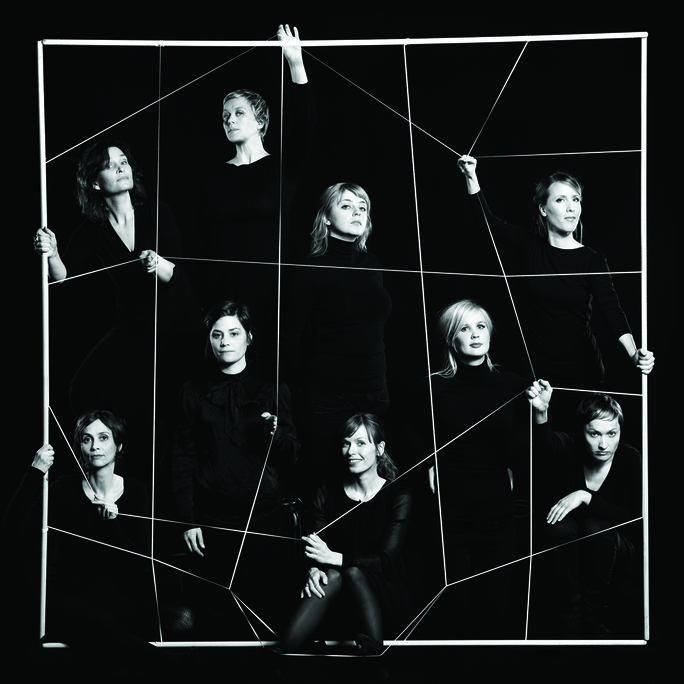5. Electronics in a vocal interplay, a project report:
Live electronics in the a capella ensemble
The main focus of my artistic research project has been to explore new roles and possibilities in the improvised interplay with other instruments. I have implemented live electronics as musical tools in my situation as a vocalist in various interplays. It has, as discussed in Chapter 2, been important for me to work with the right tools in this situation. An important part of my musical work over the years, besides these projects, has involved improvising a cappella-ensembles (Kvitretten (see section1.5) and Trondheim Voices). In seeking to explore the use of live electronics in an a cappella ensemble, I have looked for tools that can be useful in such a situation. Implementing live electronics in this type of interplay and setting is a very different task, working with a group of 9 singers, as in Trondheim Voices. The tools should provide a kind of control that makes it possible for each singer to predict the outcome of the vocal input, and the choices of sound variables should be defined and limited in number in order to help us maintain an overview and create musical meaning in the collective improvisation.
This section is about how live electronics can serve as a musical tool and lead to new strategies for an a cappella ensemble. In this respect this project represents some possible artistic extensions of my research project.
I will now demonstrate how the use of live electronics can:
- expand the sound possibilities of the vocal ensemble
- place the ensemble and each singer in a new position in respect of the sound design
- enhance a listening focus
- connect movement and sound, thereby visualising musical choices
- create an improvised “choreography”
I will do this by producing a project report from a pilot project. This project was presented at the NIME (New Interfaces for Musical Expression) international conference in Oslo in 2011.
5.1 Trondheim Voices and Stagetracker FX
Trondheim Voices[38] is an improvising vocal ensemble for which I have been the artistic and musical leader between 2006 and 2011. Working with microphones and amplified sound, there has always been a close artistic relationship between the ensemble and the sound designer/engineer; the use of reverbs, effects and panning has always been an important part of the musical expression. I wanted to further explore how the use of processed voices and effects could expand the sound of an a cappella ensemble and how we could take control of the use of effects in real time. A couple of other solutions had been tested briefly before this project; a) Handheld MIDI-controllers, and b) “Sound-zones” defined on stage by the sound engineer, following the singers' movements and changing the effects when entering the zone. Both methods had some obvious limitations that made me look for other possibilities.
Tracking the singer on stage
The system we were trying out in this pilot project was Stagetracker FX, a performer tracking and audio localisation system developed for the theatre by the company TTA in Stjørdal, Norway[39].
The system utilises hardware and software to track the positions of performers on stage and applies these positions to their microphone signals, automatically and in real time. The result is that the voices of the actors actually “follow” them as they move around the stage. This has been done in different ways in theatres for some time, but this system can make the calculations faster and more precisely than earlier systems could, which makes it possible to bring it into the concert hall without several days of preparation and adjustments[40].
Another, even more interesting possibility with this system is that the trigging of effects and reverbs can be assigned to specific areas on stage. In this way each singer gains control over the use of effects simply by moving physically.
New possibilities:
When I heard about this system and what it could do, I was interested in the following aspects – which I thought that it might be able to introduce into the performances of Trondheim Voices:
- The flexible use of effects and processed voice sound within a vocal ensemble.
- The control each singer obtains over effects by moving on stage, and the interaction between the sound and the singer’s movements.
- The visualisation of choices regarding sound, both for the performer and the audience through the movements of each singer on stage.
These elements are especially interesting when it comes to improvisation, but also as interesting possibilities for composers writing for the ensemble. It also makes the role of the sound designer somewhat different since setting up sound-scenarios for improvising will be an important part of producing the artistic outcome. In this project we were working with our highly skilled Norwegian sound designer Asle Karstad, who has also designed other productions for Trondheim Voices[41]. We were also working in cooperation with John Torger Kjelstad, one of the developers of the Stagetracker FX.
The pilot project, which ended with a 20-minute presentation at NIME 2011 was supported financially both by NTNU and the Arts Council, Norway.
5.2 The working process:
I will not go into the technical aspects of the project, but I will focus mainly on the usability, musical process, experiences and observations. A further description of the Stagetracker FX can be found at www.tta-sound.com. To put it simply: by wearing sensors and moving with wireless microphones, the system was able to detect each singer and send the signal from each singer to different effects, depending on where the singer was moving. The system was also able to give an audible illusion of the singer’s placement in the room (left/right, front/back). This last function was somewhat limited when working in a small room with only 5 loudspeakers, but it was more precise in the concert hall where we had 12 of them.
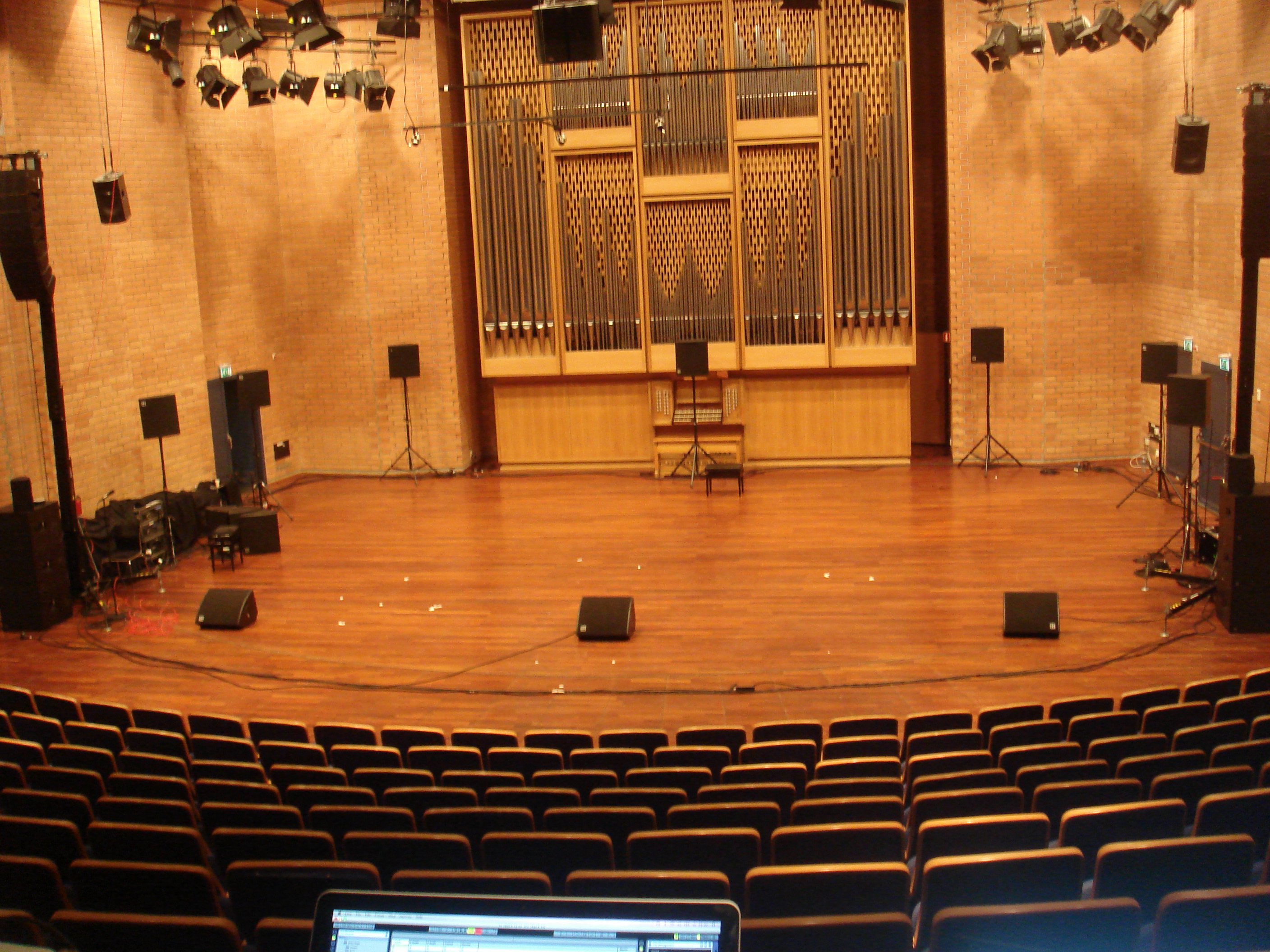
Setup at Lindemanssalen, the Norwegian Acadamy of Music, NIME 2011
The project was developed during two sessions:
Part 1: 2 days in Trondheim: setting up the system for four singers in a theatre studio room, testing functionality, effects and strategies. Discovering some technical problems, and solving them.
Part 2: 3 days of rehearsals and performance at the National Academy of Music (NMH), Oslo. The performance was a part of the NIME (New Interfaces for Musical Expression) 2011 conference [42]. We worked for 2 days in the rehearsal room, and on the last day we were rehearsing and performing in the Lindemanssalen Concert Hall at the NMH.
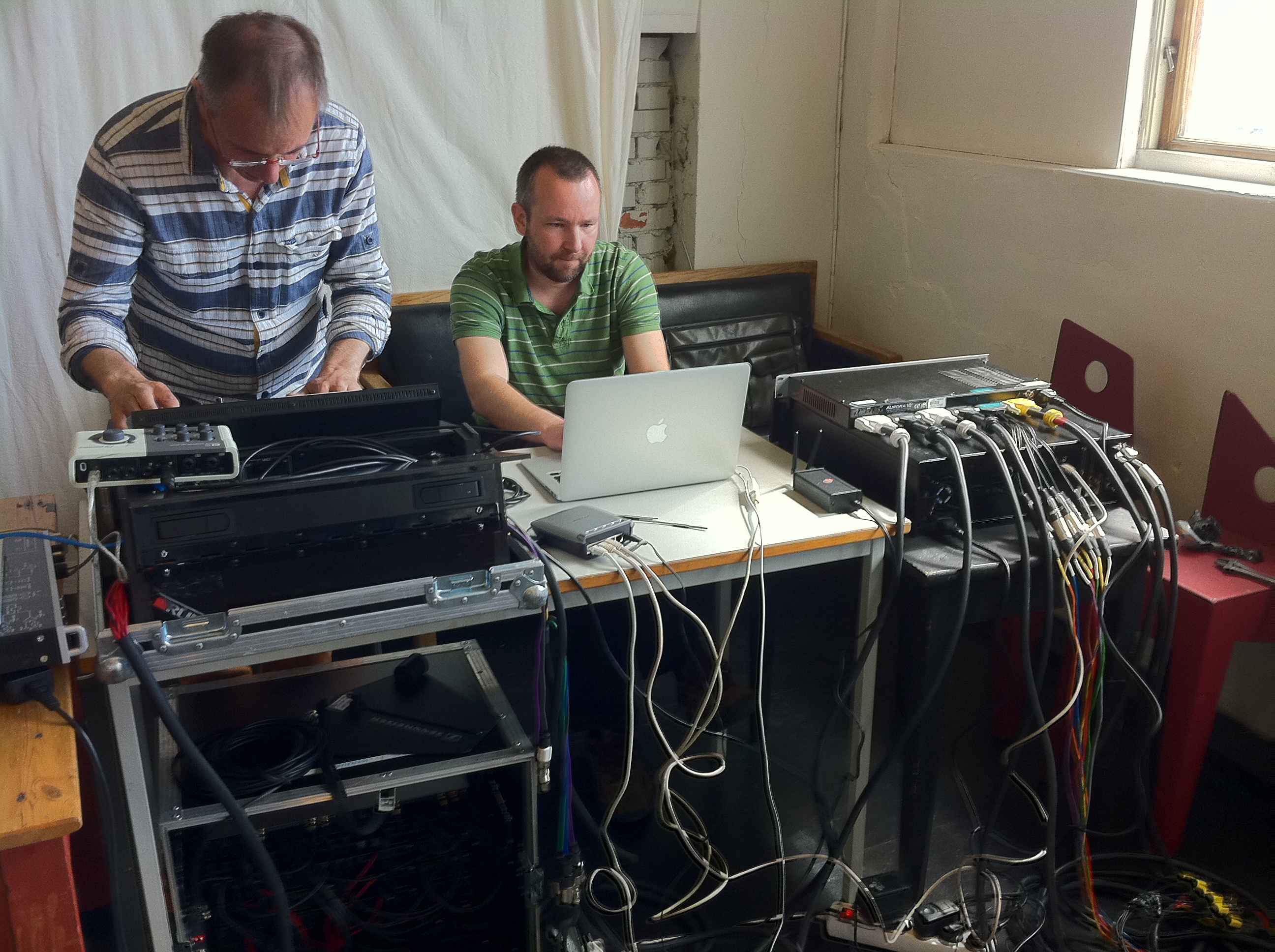
Asle Karstad and John Torger Skjelstad, Day 1 in Trondheim
First session in Trondheim:
The room was ‟divided” into 4 different ‟sound zones”, each with a specific effect assigned to it. Each zone had the form of a circle, where the effect was strongest in the centre, but gradually becoming weaker as we moved outwards. Some of the zones were set up to be ‟cross-fading”; as we stepped gradually out of one zone, we entered another, so that in a specific area we had a small amount of two effects at the same time. To start with we worked with the effects of delay, large hall, short reverse and ring modulator.
Sound zones and overlapping, simple illustration 1:
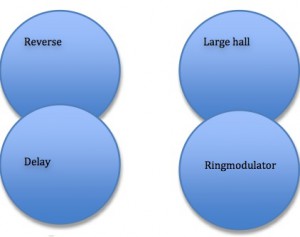
Experiences and observations, first session:
It is actually working! There was a great deal of enthusiasm in the ensemble; the sensation of sound transformation happening by simply moving in the room was inspiring. We worked with improvisations: 3 singers moving individually, and one listener/observer. We also tried moving the group of singers collectively from zone to zone. This was done in two ways: both when working with a collective musical idea that was transformed simply by the change of effects, and also by gradually changing the musical idea as a response to how the effects changed (improvising “with” or ‟on” the effect).
The most dramatically difference with this setting compared to our normal concert setup, was the new sounds that we could freely choose to work with by simply moving on stage. Watching and listening, we also observed that the movements in the groups, motivated by the will to enter a sound zone, created an improvised choreography that had a special quality. We also realised that it was even more important to focus on being disciplined and listening ‟outwards” in the free improvisation when we had all these new possibilities of sound.
These experiences were important for the further planning of the project. I wanted to have a ‟neutral” zone with a more natural/neutral reverb in the centre of the stage, and I wanted to have both the possibility of cross-fading zones and going in and out of a zone without cross-fading. A neutral zone surrounded by overlapping zones in a half-circle would allow this, so this was an ideal plan for a setting. (This exact wish subsequently turned out to be difficult, and I will return to this later.)
It was also possible to plan a way for arranging/choreographing a previously rehearsed composition based on this setup.
Second session, Oslo ,working methods
The rehearsals in Oslo were held in a rather small room for the two first days, but we managed to create an ‟almost neutral zone” for working with the change from neutral to effect. The working methods we used were similar to those we had employed during the first session, but we started with a demo from the singers that had been working in Trondheim. We worked with both improvised and more structured group movements. First and foremost there was a need to focus on and rehearse the connection between input and output in the different zones. The different characters of the effects were tried out and discussed. We also changed from the ring modulator to a slicer effect when there was no direct voice signal coming out, only the processed sound. ‟Fading” in and out of, and ‟cross fading” between the zones were tried out. We also used techniques that we had been using earlier, introduced to us in a commissioned piece by Mats Gustafson[43] in 2009. In this piece the composer is also the director of the ensemble, with gestures for different musical cues within partly improvised, partly defined material. These techniques can easily be used within groups of the ensemble as part of a free improvisation; each singer can take the initiative to become the director of the rest of the group. Our work with the zones created different groups at different times, gathered in the same zone, so this was a very natural possibility. We also created a setup and ‟choreography” for a composition [44]. The spatial placement of the effects was changed accordingly and we rehearsed a shift from a setting for improvisation into a setting for this composition.
5.3 Concert/presentation
Example V, 1: Excerpt 1 :
5.3.1 Final setup
It was a great pleasure, but also hard work, to install the system (almost) as we wanted, in the concert hall (Lindemanssalen, NMH). We managed to create a neutral zone in the middle, but for practical reasons the linked effect zones did not form a half circle, but a square.
Sound zones and overlapping, simple illustration 2:
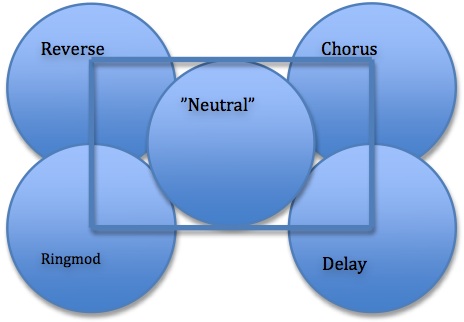
The lines indicate the stage area that we used. The cross-fadings were less controllable than the figure suggests. Note that the middle of the circle is the max effect point.
The stage was much bigger than the room we had been rehearsing in, and we spent some time simply exploring the areas of the zones, how the room “worked”. We improvised a sequence, rehearsed some choreography for the composition and had a short briefing about strategies. Then we held the concert later on in the evening.
Videos: it is not possible to represent the spatial aspects of the sound here, and it is also difficult to capture this performance visually, but the video clips will still give an impression of the performance.
Example V, 2 : Excerpt 2:
Example V, 3 : Excerpt 3:
5.3.2 Experiences and observations, second session
It was very important for me that this new tool seemed to be meaningful and inspiring for the whole ensemble. I will look at some important observations in this process:
Listening focus
Being 8 singers improvising together, the risks of descending into chaos rather than achieving form and clarity are always substantial. The rehearsal of, and focus on, the effects could actually help us to get into a listening mode that, to me, seemed somewhat different what we experience when we work without effects. It seemed like a natural adjustment of focus; a bit further away from our own sound impulses, towards hearing the actual outcome of it – as part of the music produced as a whole. The use of effects produced a lot of new information in the music, so we should – and could – at least for some parts, think and act minimalistically. This is a process that is useful to ‟bring back” to the work we do when we are improvising without the effects.
Movement, zones and structure
The zone division created a structure for the improvisation in several ways. Being in a sound zone, it felt natural to relate one's musical ideas to other singers in the same zone. This seemed to help coherent group ideas to develop in a clearer way than usual. The flexibility of moving between zones also made it natural to step aside (out of zones) and be quiet, and this created more ‟space” than usual in our improvised sessions. The decision-making that motivated movements in and out of zones or stepping aside, required determination about what the singer wanted to do, to a larger extent than when standing still on the stage. This seemed to be reflected both in the musical outcome and in the appearance on stage.
Visibility and improvised choreography
Based on the responses received after the performance, the visualisation of choices seemed to play an important part both for the audience and for us. The video of our rehearsals and performance shows an improvised choreography that follows musical choices in a rather relaxed and natural way. One of the singers expressed very early that this was a great way to move on stage; not motivated by a directed choreography, which she sometimes found difficult, but as a result of her own musical choices.
Comments from vocalists in the ensemble
The overall response from the ensemble confirmed some of my hopes about how the singers would experience the system as a tool - illustrated by some quotations here (translated from Norwegian):
‟ It gives me a kick to feel like part of a large mixing board, to see the others and relate to both what I see and hear, move in relation to the others and the world of sound I want to go into – see who is standing there and hear what sound they make, and then to enter this with my impulses, go from there into something new- all in all the fact that the movement, sound and room are so closely connected is incredibly inspiring!” (Singer, T.V)
“A technical extension of the voice’s possibilities, which opens up for a new musical vocabulary, collectively and as soloists.[ ..] In this phase, when still new, you use your ears in a very structured way, where you have to make room, let the sounds be “clear” in the wholeness, to make the tool come to into its own." (Singer, T.V)
“Good to have freedom from cables and controllers, the project is trigging ideas about different possibilities with effects, including more detailed adjustment of zones, to get more of the “morphe-zones”[…] Inspiring to get a direct link to movement, to become a “fader” out there[…]the system works in an intuitive and clear way.”(Singer, T.V)
The singers also had several ideas and comments about the limitations and how we could go further with this system:
- It is a challenge that the stage, and the distance between the zones, is so great. It takes time to move, so this sometimes slows down the time from impulse to sound.
- Going further with this, it will be necessary to work for a longer period with the system, really getting into the connection between impulse and response, and experimenting with different effects.
- An idea would be to have a combination of a bigger “neutral zone” (it was a challenge to make this large enough here) and the other zones, to be able to combine the more traditional concert setting with this possibility. Maybe three zones would be enough in this combination.
- It would be exiting to have effects that are triggered by special vocal inputs only – or that who reacted differently to different inputs.
5.4.Closing remarks and outlook
The system we tried out seemed to be a useful tool for the ensemble. Although it is possible to set it up in a rather short time when compared to similar systems, it is still a demanding tool when it comes to the technical setup and size of the stage, and this has to be considered when going further with this work. It is also important to rehearse using the system, to fully be able to use it – especially as a tool for improvisation. A commissioned work involving this system is planned for some time in the future, which would will give us the chance to develop the project further.
[38] A professional ensemble of 9 improvising vocalists, administrated by the regional Jazz Centre MNJ; see www.trondheimvoices.com
[39] www.tta-sound.com
[40] Some of the formulations here are from the tta-sound website.
[41] ( BINGO!! (2008) and IMPROVOICING (2009))
[42] http://www.nime2011.org
[43] Mats Gustafson: Swedish free jazz saxophone player and composer, see http://matsgus.com/
[44] “Slipp” by Ståle Storløkken, commissioned for BINGO!! 2008
